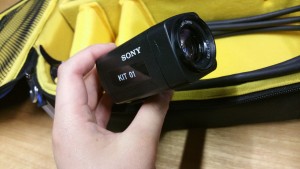Imagine an eye unruled by man-made laws of perspective, an eye unprejudiced by compositional logic, an eye which does not respond to the name of everything but which must know each object encountered in life through an adventure of perception.
– Stan Brakhage.
Throughout the first half of this semester I have been constantly trying to project my own living experiences onto screen (or more accurately in this case, recreate it through the act of filming). I saw the camera as only a lifeless tool that assisted my intentions (to communicate a sense of oneness with nature and a less human centered worldview through relationships with nonhuman characters). But it wasn’t until coming across Stan Brakhage’s idea of defining the camera as a non-human perspective that I realised what we often take for granted. The camera sees things that we are too limited by our human subjectivity to see. Though not an entirely an omniscient perspective (the very word implies the contrary), as reminded by an earlier inspiration John Smith’s The Girl Chewing Gum (1976) which sparked my initial investigation, the camera has its own unique perspective. Brakhage’s film Window Water Baby Moving (1959) presented the events of a birth from a neutral perspective yet portraying a realistically fragmented reality that is truer to our experiences in life than the conventional device of filmic continuity.
Since then, I have performed several experiments exploring the act of film by ways of seeing, filming and moving as well as investigating the relationships between them. Reflecting on my experimentations and observations, my research have diverged from the original research I proposed to conduct in week 8. Rather than developing a set of auteurist codes and personal filmic devices, I discovered tools that can be used to creatively navigate or engage the world around me. The act of filming when conducted aimlessly as a form of meditation, is an effective way to implement experimentation into the creative process.
I have also observed several classmates on their research projects as well as other productions outside of class. During these events, I observe and compare their methodologies to my own developing ways of working. This led to a further curiosity of whether or not they also contemplate about the meaning of the act of filming and the relationship between observing as a personal experience and the decision to frame or film something with the eye of the camera. With this in mind I conducted some recorded conversations with the people I have been working with to generate discourse surrounding this topic. The process of having conversations is an organic and dynamic one that I have discovered as part of my methodology, which I will continue to use throughout my creative endeavours. Through these conversations, not only did I get to know a bit about what others are thinking and how they perceive the act of filming. As well as generating a much needed local discourse surrounding film culture within the student community, it also brought upon insights on aesthetics, cinema, experience, identity, philosophy, culture and even politics. This became one of the significant revelations during this process: that cinema and filmmaking should be explored constantly in connection to the world around us, particularly in contemporary society.
Another epiphany led to the decision that a compilation video of my journey exploring the different perspectives on the act of filming, would be a more suitable documentation rather than creating a conventional scene or simply writing a reflection. The experimental footage and recorded conversations formed the basis for this visual summary:
As a result, accompanying this written statement is a film essay recapturing the journey of exploration and a concluding conceptual performance piece that summarises the relationship I have with the camera.
